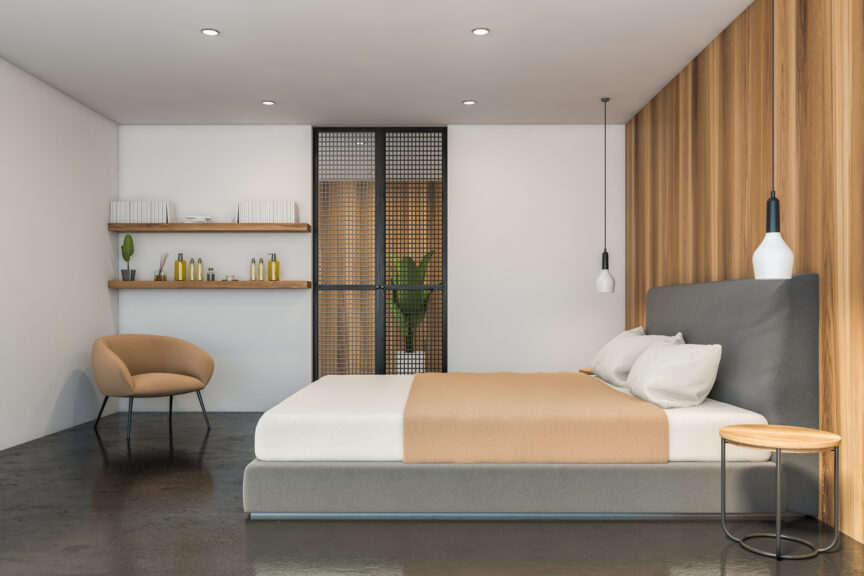Giovanni Valle is a licensed architect and LEED-accredited professional and is certified by the National Council of Architectural Registration Boards (NCARB). He is the author and managing editor of various digital publications, including BuilderSpace, Your Own Architect, and Interiors Place.
Wood paneling offers improved insulation, acoustic, and overall aesthetic appeal. Whether you want to install, replace, or are concerned about the structural integrity of existing paneling, you may be curious if it needs drywall behind it.
Wood paneling has drywall behind it for additional support. The wall will bend and break without drywall or another robust material behind it. It should be nailed to the drywall to prevent it from falling off or loosening from the adhesive.
Throughout this article, I’ll talk about why you need drywall behind wood paneling, how it’s secured to the surface material, and what happens if you add it without drywall behind it.
Do You Need Drywall Behind Wood Paneling?
You need drywall behind wood paneling because it stops the paneling from breaking, bending, and warping. Drywall isn’t the sturdiest material, but it’s more than enough to support wood paneling and provide the necessary benefits. If you don’t have drywall behind the wood paneling, you can remove the panels and put drywall over the studs.
Some people build wood paneling without drywall, but it’s a cheap workaround. They’ll end up repairing the wood paneling, likely replacing it with drywall in the long run. Placing wood panels without drywall in main rooms is often against various local building codes.
Speaking of which, always check with a nearby contractor before placing wood panels if you don’t intend to use drywall. Those who want to use drywall for its countless advantages should use longer nails and construction adhesives to secure the wood to the walls. Let’s dive into the much-needed factors in the following section.
Is Wood Paneling Glued to Drywall?
Wood paneling is glued and nailed to drywall. It’s important to use construction glue to keep the paneling from bowing, but the nails are irreplaceable for structural integrity. There should be screws on each stud and every six inches along the outer edges of each panel. These screws act as vices to cure the glue.
Keep these things in mind when gluing wood paneling to drywall:
- According to Millard Lumber, you’ll need 1 ⅝” screws every four to six inches around the seams. Wood panels are weakest near their outer edges and seams (at each connection point). It’s essential to use long screws to secure them to the studs, drywall, concrete, or whatever else is behind the wood panels.
- Cover the back of each wood panel with a thin layer of construction glue. Adhesives are an absolute must if you’re applying wood paneling to drywall. Choose construction glue to prevent it from loosening and shifting, and from naturally occurring settling.
- Always use drywall screws when drilling into any portion without studs. Drywall screws expand and prevent them from falling out of the wall. Otherwise, some panels could loosen if they encounter extreme temperatures. Check the screw’s depth to know if they’ll penetrate through the drywall.
- Make sure there’s a screw on each stud (typically every 16 to 24 inches). Studs are the primary support beams for drywall. You can ensure your wooden panels are secured by drilling into each stud. Use a stud finder or tap the wall with your knuckle to locate and mark each stud.
Can You Install Wood Paneling Without Drywall?
You can install wood paneling without drywall if you have plywood, furring strips, bricks, or concrete. However, drywall is the most practical solution for most homes because it’s lightweight and affordable. Furthermore, all you need are drywall screws. Installing wood paneling without a supportive backing will cause problems.
Here’s what could happen if you install wood paneling without drywall:
- There’s an increased fire risk. Home Stratosphere claims you should never place wood paneling near furnaces and other heat sources if you don’t have drywall behind it. Wood paneling holds higher temperatures for much longer, and it’s significantly more flammable than drywall.
- Your wood paneling will likely bend or bow from temperature fluctuations and pressure. Wood is well-known for expanding during the hot months and shrinking when it cools down. If you don’t have drywall behind the wood paneling, there’s a good chance it’ll have gaps at each of the seams.
- You’ll notice stress cracks around the edges of the wood paneling. All buildings are constantly shifting and settling. The drywall and studs usually take the bulk of the pressure and evenly disperse it. However, without these supports, the wood paneling will crack along the paths of least resistance.
- Almost anything solid and heavy can break through it. Wood paneling is far from durable compared to studs, concrete, bricks, etc. You can bend, dent, or shatter the paneling when moving furniture, accidentally falling on it, etc. Adding a thin layer of drywall with studs makes a world of difference.
- The paneling won’t provide enough sound dampening for most people. While wood paneling has wonderful acoustics, it won’t insulate the sound coming into the room without a supportive layer. It’ll be as if you had a thin sheet of plywood between you and the neighboring room.
Wood paneling is a great modification, but it requires something behind it to prevent it from getting damaged. If you don’t have drywall, there are plenty of other options you can use, as mentioned above.
Final Thoughts
Wood paneling offers numerous benefits, most of which are ineffective if you don’t have drywall behind it. Remember, proper nail length and placement are crucial. If you use the wrong nails, the wood paneling will quickly fall off the drywall. Wood paneling can go over wallpaper and painted walls without a problem.
Share this Post

